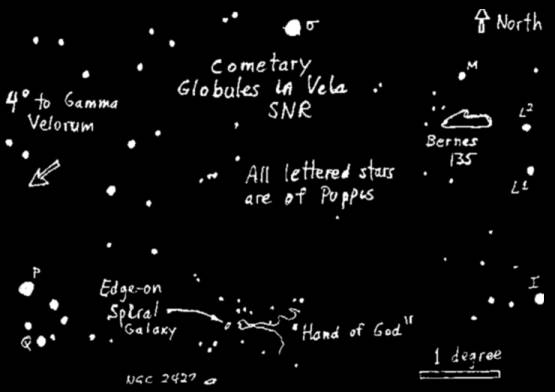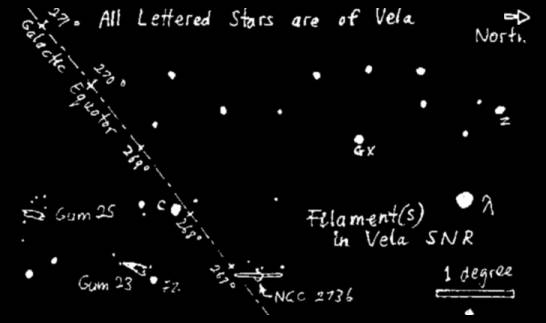BNGC 8. The Grandest Supernova Of Them All
Back to Index of Beyond the NGC
By Steve Mencinsky, 1993
As evidenced by the "ohs" and "wows", there would have been very few indeed in the audience who were not absolutely thrilled by David Malin's photos. Indeed, your author was so motivated that he decided to observe a few of the obscure items that David showed.
This month's BNGC sees us in the largest (in angular size) supernova remnant of them all - the one in Vela. Although map 397 of Uranometria II gives some idea of the size, m actual fact the photographable part is considerably larger. According to our Technical Officer, what Uranometria II labels as "Gum Nebula" is in fact "Vela SNR", of which some pieces have Gum designations.
There are several small fragments on other charts in Uranometria II that are associated with this SNR, but this is not obvious as these fragments have other names. It is these pieces that form this month's article.
Regular readers of Universe would no doubt be aware of the beautiful "coffee table" picture book "Exploring the Southern Sky" by Laustsen, Madsen and West, which was enthusiastically reviewed by Max Gardner some time ago. Confession time: it was poring through the book that inspired your author to begin writing this column, almost a year ago. Many past (and future) articles are from this book, which has the priceless feature of a Reference section (unmentioned by Max) at the back where details of EVERY photo such as exposure, image scale, coordinates, etc are listed. By duly transferring some of this information to his copy of Uranometria II, your author has been able to successfully observe many of these lesser-known items. Specifically, past BNGC items from this book are N70, the "N" nebulae in the Small Magellanic Cloud, the companion to NGC 253, Bernes 135, "Hand of God", and Baade's Window. There are several more yet to come.
Bernes 135
07h 19m -44° 40'
Listed as a cometary globule, none of the emission nebula was visible through the 45cm with any filters. However, a careful inspection of the ESO book photo shows that the tail of the globule is quite "dark" in the sense that through the nebula are visible fewer background stars than around it. Indeed, through the telescope it appeared much like the Barnard dark nebulae in Scorpius and Sagittarius. Intriguingly, this nebula, like many of the fainter dark (is that a logically consistent combination of concepts?) Barnard nebulae is much easier to see when viewed slightly out of focus. You may wish to try this yourself on Barnard 86.
David Malin's "Hand of God"
07h 34m -46° 52'
As you may be able to deduce from the diagram, this object derives its name from its shape: a cometary globule shaped like a grasping hand, attached to an "arm" (complete with wrist, elbow and shoulder). Immediately beyond the "hand" is an edge-on spiral galaxy, the combination appearing as an outstretched arm reaching out for the galaxy. David's first photo and the ESO book show that by far the densest portion of the photo is the galaxy, so that was where the greatest hope for a sighting lay. Unfortunately, the closest examination of that area of sky revealed no trace of it. However, with an OIII filter, the portion of the nebula beyond the "arm" (ie. the "shoulder") was faintly visible.

Extension of NGC 2736
09h 09m -45° 52'
Never let it be said that your author is slow on the uptake: it took only four hints from Chris Ross to turn the telescope onto this one! Although the brief for BNGC rules out NGC objects per se, this item appears to be a legitimate exception. Herschel's description of NGC 2736 indicates a very small nebula, whereas the OIII filter (as often happens) opens up a whole new image. Appearing for all the world like the portion of the Veil Nebula that is near 52 Cygni, a twisted writhing ghostly cigarette-smoke-plume more than half a degree long was centred on the position of NGC 2736 as shown on Uranometria II. On perusal of the NGC, it appears that this is the only portion of Vela SNR in that catalogue.
Gum 23
08h 59m -47° 25'
Inspired by the above, Chris and I moved south some 1.4 degrees, along the line of the filament, to another success. Utterly invisible without filters, the OIII showed a diffuse triangular cloud, brightest at the apex, similar in appearance to the classic 19th century drawings of comets, perhaps 20 x 5 minutes of arc in size.
Gum 25
09h 02m -48° 40'
1.4 degrees south again, and again along the line of the filament, is another very faint and diffuse cloud, "football" shaped, some 15 x 5 minutes in size. Visually, this appears to be the end of the trail.

Perhaps the most fascinating aspect of the last three items is that they are equi-spaced at about 1.5 degree intervals (ie. quite a long way apart from each other in comparison to their sizes), they all lie roughly in a straight line, with the individual objects themselves oriented along that same line. The question, then, is inevitable: are these objects all distinct and separate, or are they all part of the same long filament? Maybe our astrophotographers could answer this question?
One final item: the size of the SNR complex. According to the ESO book, the cometary globules are all illuminated / excited by Gamma Velorum. Your author invites you to take your star atlas outside on a suitable evening, and examine the relative locations of this star, the objects it allegedly influences, the filamentary nebulae, and the location of Vela SNR proper. Observing all of the above with a 2-metre focal length telescope requires three different footstool positions, a long, long way apart. This is indeed a gigantic nebula!

